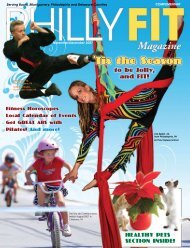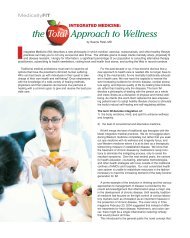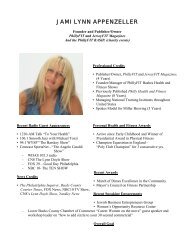PhillyFIT Magazine
PhillyFIT Magazine
PhillyFIT Magazine
Create successful ePaper yourself
Turn your PDF publications into a flip-book with our unique Google optimized e-Paper software.
to significant vomiting. If your pet has access to holly and<br />
shows these signs, seek a veterinarian’s advice.<br />
3) Amaryllis. Amaryllis is a showy flower commonly used in<br />
Christmas-time potted or cut arrangements. It comes in white,<br />
red, striped, and other floral pattern varieties. Primarily the<br />
bulb and leaves of amaryllis plants are toxic to dogs and cats;<br />
the flowers are somewhat less so. Ingestion of plant parts leads<br />
to poor appetite, vomiting, diarrhea, and hypersalivation.<br />
Ingestion of large quantities can lead to sedation and seizures.<br />
If your pet eats amaryllis, call a veterinarian for advice.<br />
4) Poinsettia. While poinsettias have a reputation for being<br />
toxic holiday plants, in reality they are only mildly toxic to dogs<br />
and cats. The sap causes skin irritation, and ingestion of the sap<br />
can cause oral irritation and possibly vomiting. However, signs<br />
associated withpoinsettia ingestion are usually quite mild to<br />
absent.<br />
5) Rosemary and Other Oily Plants, including Potpourri.<br />
The oils in these fragrant plants can cause significant irritation<br />
to the mouth and gastrointestinal tract, and animals should be<br />
prevented from contact with these items. If your pet ingests<br />
suchitems, call a veterinarian for advice.<br />
6) Many other plants such as Christmas cactus, kalanchoe,<br />
tulips, jade, and many, many other houseplants can be toxic to<br />
dogs and cats. Lilies of most types are fatally toxic to cats.<br />
There are open-access lists of toxic and non-toxic plants available<br />
at www.aspca.org/Pet-care/poison-control.<br />
Holiday Environs Potentially<br />
Dangerous to Pets<br />
Many holiday decorations and other environmental items can be<br />
dangerous to dogs and cats in some situations. When decorating<br />
your home for the holidays, take your pet’s temperament<br />
and access into account when selecting items and setting things<br />
up.<br />
Electrical cord exposure can cause oral burns, seizures, collapse,<br />
or severe breathing problems. Batteries are dangerous if<br />
punctured or swallowed. If your pet shows any of the problems<br />
listed here, or chews or swallows a battery, take her to a veterinarian<br />
immediately.<br />
3) Stuffed Toys. Stuffed toys are great distractions for dogs.<br />
Be sure Fifi’s toys are safe by removing sharp or stringy elements,<br />
and remember that your dog should always be supervised<br />
when playing with toys. Dismembering, de-stuffing, or<br />
eating the innards of stuffed plush toys can cause life-threatening<br />
gastrointestinal obstruction, which usually causes moderate<br />
to severe vomiting.<br />
4) Candles. Be sure that lit candles are kept out of paw and<br />
tail’s reachat all times!<br />
Most importantly, use your best judgment when it comes to your<br />
pet and holiday exposures. If you have questions or concerns<br />
about a possible exposure, be sure to call your veterinarian<br />
immediately or a twenty-four hour hospital if your veterinarian’s<br />
office is closed. Have a veryHappyHolidaySeason!<br />
Jamie M. Burkitt, DVM, Diplomate ACVECC, Red Bank Veterinary Hospital –<br />
Cherry Hill<br />
• Duke University, Bachelor of Science 1992-1995<br />
• University of California at Davis, Doctor of Veterinary Medicine 1996-2000<br />
•UniversityofPennsylvania,InternshipinSmallAnimalMedicine&<br />
Surgery – 2000-2001<br />
•LecturerinEmergency&CriticalCare,UniversityofCaliforniaatDavis–<br />
2001-2002 and 2005-2007<br />
• University of California at Davis, Residency in Emergency & Critical Care – 2002-2005<br />
• Assistant Professor, University of California at Davis, Department of Surgical & Radiological<br />
Sciences, School of Veterinary Medicine – 2007-2008<br />
• Private Veterinary Consultant – 2009-2011<br />
•JoinedRBVHTintonFallsandRBVHCherryHill–2011<br />
1) Christmas Tree. Fortunately, the natural evergreens generally<br />
used as Christmas trees are non-toxic or only slightly toxic to<br />
dogs and cats when ingested. However, tree needles can sometimes<br />
cause direct mechanical irritation to the mouth, esophagus,<br />
and stomach, and can thus cause vomiting or (rarely) puncture.<br />
Consider any chemicals added to the tree’s water supply –<br />
many animals like to drink from the Christmas tree water.<br />
Chemicals added to the water or sprayed on the tree as flame<br />
retardant can cause toxicity. Households with pets should not<br />
use tinsel or stringy garlands that could be chewed and swallowed<br />
because these items can cause life-threatening gastrointestinal<br />
obstruction. Tall trees should be anchored so that pets<br />
cannot pull them over, causing either trauma to themselves or a<br />
fire hazard. Artificial trees themselves and flocking (artificial<br />
snow) have not been reported to be toxic, but it’s important to<br />
remember that large ingestions of anything can cause obstruction<br />
that could require emergency surgery, and that some artificial<br />
trees or flocking may be treated with chemicals that have<br />
potential for toxicity.<br />
2) Electrical Cords and Batteries. Keep electrical cords out of<br />
reach to avoid electrocution. Chewing on electrical cords is a<br />
particular danger in curious, playful puppies and kittens.<br />
November/December I 215-396-0268 I www.phillyfit.com <strong>PhillyFIT</strong> I 41
















